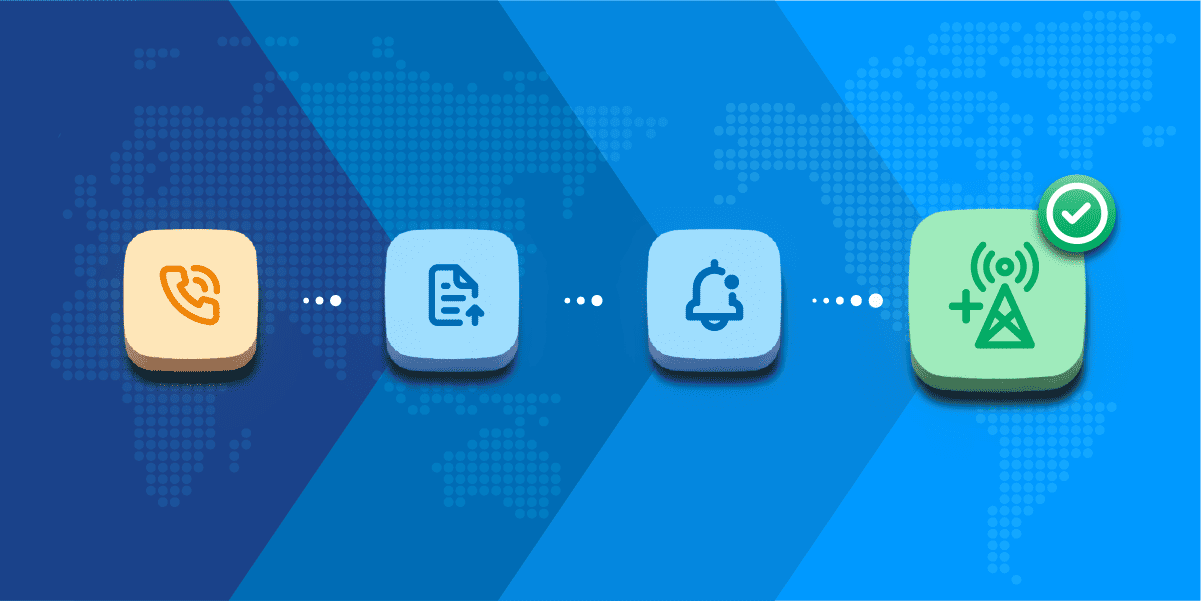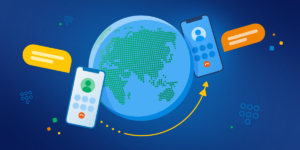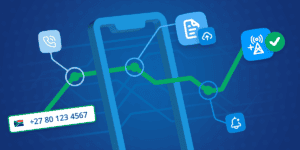The Ultimate Guide to International Number Porting

Just as your logo or tagline is synonymous with your brand, so are your long-term business-critical phone numbers.
Your customers know them– they’re on all your promotion and communication channels. But what do you do if your brand expands into new markets where your current voice carrier doesn’t offer service?
Fear not– international number porting can help you expand your voice service to new markets using those same phone numbers. Below, we’ll walk you through number porting and what you can expect from this convenient voice solution.
What is International Number Porting?
International number porting is the transfer of existing phone numbers from one carrier to another.
It’s a voice service that allows businesses to retain their long-term phone numbers, expand their global footprint, and escape expensive international call rates associated with their landline, mobile, and virtual numbers. But cost reduction isn’t the only benefit that number porting provides– there are a lot more advantages for global businesses.
Number Porting Benefits
- Preserving brand identity: Number porting allows you to keep your brand’s phone numbers as you modernize your infrastructure and expand to new business markets.
- Cost-efficient: Porting business numbers can help save you money on international call rates and number management overhead through carrier consolidation.
- Customer engagement: International number porting gives your business a global as well as local presence, improving the contact accessibility of your brand and increasing customer engagement.
- Service uptime: A seamless transition from one provider to the other removes any worry of voice downtime, so you don’t miss a single critical customer call.
- Time-saving: Porting is quick and easy with porting experts in your corner and an intuitive platform where you can manage your phone numbers in one place.
Why You Might Want to Port Your Numbers
There are several reasons why you might port your business phone numbers. Let’s take a closer look:
1. Expand to New Markets
Number porting can help you reach your new customers internationally. This allows customers to contact the business directly with easily accessible numbers from anywhere.
2. Better Call Rates
Your voice infrastructure and current carrier can greatly influence your call rates. If you’ve been shopping around and noticed you’re paying more than you could be with another carrier, number porting is a great way to get those more favorable rates and lower your Total Cost of Ownership – all while retaining your critical legacy numbers.
3. Consistency Across GTM Channels
Phone number consistency across your go-to-market (GTM) channels ensures that your customers and partners have a unified point of contact to call about their needs.
Additionally, porting enables unilateral call quality so you have the same uptime and MOS in one market as you do in another.
4. Two-Way Calling
Porting allows you to move to a provider that offers inbound and outbound calling on a single number. That way, your hybrid call strategy can support two-way calls in your contact centers using familiar and recognizable numbers.
5. Expert Provider Support
If your current provider isn’t meeting expectations, porting allows you to transfer your business-critical numbers to a carrier with renowned customer service and telephony expertise. This ensures minimal disruptions, faster problem resolution, and an overall better support experience without having to forego your established business numbers.
6. In-Country Regulation Management
It can be challenging to keep up-to-date with the diverse telecommunication regulations around the world. By porting to a provider with in-country expertise, you can ensure compliance without administrative headaches.
7. Tighter Security Posture
Porting allows businesses to deploy more security and control over their voice services. Transferring your numbers to a carrier with robust encryption and security measures helps to safeguard your voice services and customer data.
How International Number Porting Works
As your business grows beyond national borders, it becomes increasingly important to make sure you’re connecting with your customers using the phone numbers most suited for your call strategy.
The flexibility of international number porting extends across various types of numbers including…
Keep in mind that a typical timeframe for completing the number porting process for an international number is 6 weeks. However, there are a few factors that can impact the speed of your porting process:
- Bulk porting: Porting a large quantity of phone numbers may require more time.
- Documentation accuracy: Inaccurate documentation can delay the porting process.
- Experienced porting experts: Partnering with a knowledgeable porting team can help expedite the process.
General Requirements for International Porting
During the process of expanding into new markets, in-country regulators require documentation to ensure compliance as companies expand into their countries. Here’s what you should come prepared with when you port international numbers to a VoIP carrier:
- Letter of Authorization (LOA) and/or Letter of Intent (LOI): A document that safeguards the interests of all parties involved in the number porting process, ensuring clarity, legitimacy, and a smooth transition.
- Proof of Ownership: This is often in the form of an invoice, and serves to verify ownership to the numbers being ported. This helps prevent unauthorized porting and ensures a smooth transition.
- Passport and IDs: These are commonly required to validate the identity of the individuals initiating the porting process.
Best Practices to Safeguard International Number Porting
Keep in mind, international number porting may take a bit longer than porting a number to a local service provider. There are several things you can do to effectively impact the process and get it moving swiftly, so you can connect with your audience even faster.
1. Confirm your number is portable.
Some voice service providers limit ports through contractual terms that state phone numbers cannot be transferred, and then there are some phone number types that just aren’t portable.
Check your current provider’s contract to ensure you can port out your numbers. Additionally, many VoIP providers, like AVOXI, offer automatic tools to test the portability of your phone numbers.
2. Stay with your current provider until porting is complete.
Don’t cancel on your provider until after the porting process is complete and you have received authorization from your new provider. If you cancel prematurely, there’s a chance you might lose your number entirely and prolong the processing time.
3. Obtain a copy of your invoice.
Your phone number invoice encompasses important information required by your new provider to facilitate the porting request. This information includes customer ID, phone numbers linked to your account, usage history, as well as your service and billing address.
4. Begin the conversation.
After obtaining the invoice copy, you can initiate a conversation with the new provider regarding your goal to port international business numbers. Prior to speaking with a representative, it’s likely that you’ll need to complete a digital pre-requisite form.
5. Sign and send an LOA.
You will need to fill out and sign a Letter of Authorization (LOA) or Letter of Intent (LOI) to your new provider. Once they have received this and any other necessary documents, the carrier will commence the porting process and establish contact with your current provider. Keep in mind this procedure could take several days to finalize.
6. Test it.
After your new provider has successfully migrated your number onto their network, conduct a series of both incoming and outgoing testing calls to ensure the connection and quality meet your standards. Should you encounter any service-related concerns, don’t hesitate to contact your account manager or support team for assistance.
Commonly Asked International Number Portability Questions
It’s important to have a general understanding of international porting before you dive deeper into the process with specific voice carriers. Below, we’re answering some common questions about international number portability for global businesses.
The cost of porting international numbers varies by service provider, number type, porting country, and terms and agreements.
There is potential for admin and/or processing fees. Reach out to both your current and new service providers to inquire about specific charges that can influence the porting cost.
You have to be in compliance with the country you want to do business in. That’s why voice carriers require specific documentation before they can port your phone numbers. You’ll typically need:
- Letter of Authorization: This document authorizes the porting process by allowing your new provider to contact the current provider.
- Proof of Ownership: A PDF version of your invoice, linking your number(s), name, and billing address.
- Number Porting Form: Additional forms might be required (excluding the US or Canada).
Ready to port? Our specialized porting team here at AVOXI can help. Their in-country regulation knowledge and extensive carrier relationships keep your business moving through a seamless and transparent porting process.
Of course! Transferring numbers to a VoIP line is quick and easy with most VoIP services. Other lines you can port to include mobile and landlines.
Yes. International ports can be rejected because of inaccurate data provided, outstanding bills, contractual obligations with the current provider, technical issues, and regulatory restrictions.
If a port is rejected, you should communicate with both your current and desired service providers to address the specific issue.
Efficient International Phone Number Porting to AVOXI
International number porting is a great way to save costs and ensure brand consistency as you scale your business. And with a trusted team of experts to support your needs, the porting process should be quick and streamlined.
As you continue to research porting for your contact centers, our webinar Optimizing Your International Number Porting Strategy can help you gain a deeper understanding of the porting process tailored to grow your operations.
Related Articles
Contact Center Phone Numbers: Best Practices to Optimize Your Global Reach
Grow your contact center’s phone number portfolio and optimize global reach using virtual number best practices. Learn how it improves your voice engagement and more.
Continue Reading >International Phone Numbers for Better Global Communications
Enhancing your global communications? Learn how the right international phone numbers can help you scale your portfolio.
Continue Reading >How Business Phone Number Porting Works
The porting process for business phone numbers is easy with expert-level support. See the porting step-by-step process.
Continue Reading >
Katharine Kellar
( Director of Marketing Communications )Katharine Kellar is AVOXI's Director of Marketing Communications with a track record of building and scaling brand, PR, and content functions that drive business impact. With expertise in corporate communications, thought leadership, and reputation management, she transforms complex ideas into compelling narratives that engage audiences and fuel growth.


